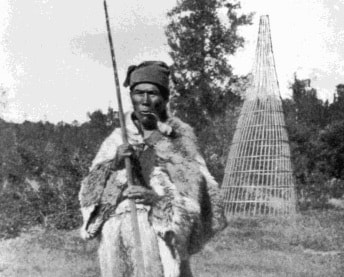Residents and visitors of Vanderhoof can soon get a glimpse of local living before European contact through a leisurely stroll.
On over 20 acres of land southwest of Nechako Valley Sporting Association’s grounds, some remnants of the Carrier fishing village of Noonla remain undisturbed by modern development to this day. The NVSA, having recently acquired the property, is looking to build a 3.5-kilometre self-guided trail that showcases archaeological features such as culturally modified trees, fish cache depressions, and pit dwelling remains, said NVSA director Paul Collard.
“I think it’ll be interesting because most people don’t have any idea how people [in the area] used to live,” Collard said. “That’s the only piece of land left not disturbed by industry use.”
To be accompanied by interpretive signage, the proposed trail will be built entirely with hand tools — without motorized excavation of any kind — to preserve the archaeological values, said NVSA director George LaBrash, who presented the project to Vanderhoof’s district council with Collard on Nov. 7. Chief and council of Saik’uz First Nation supported NVSA’s acquisition of the property, and the First Nation community would be involved and consulted throughout the project, he said.
Though only a preliminary archaeological impact assessment was conducted on the site, oral accounts from Saik’uz elders in the 1970s and 1980s provided snippets of what Noonla may have looked like, said LaBrash, an archaeologist and retired teacher who managed Saik’uz’s adult learning program and studied the once-thriving Chinlac village at the confluence of Stuart and Nechako Rivers.
Noonla, situated by a shallow portion of the Nechako River, was a river crossing location for the “grease trail” indigenous trading route that extended west to Bella Coola and north to Stuart Lake. Grease refers to the trading staple Eulachon, a small fish that was rendered into fat — drops of which often fell onto the trail.
Before the construction of Kenney Dam, the location was also a spawning area for Chinook salmon and an important fish harvesting site for local indigenous people.
“I believe in about 1903, ice blockage on the Nechako flooded out Noonla, leading to loss of lives,” LaBrash said. “Survivors decided to no longer have a permanent settlement there as a result.”
Abandoned as a permanent home, the site was then used occasionally for teaching young people how to put up fences to harvest some salmon. Now it’s not used by the local aboriginal people, as a general rule, he added.
“Our objective is to try to provide a window into the past, for not only local residents and also school children and visitors and anyone who would be interested to get an idea of the area’s prehistory,” LaBrash said.
With the possibility to be connected with the nearby Redmond wetland conservation and under-development trail system, the project can help expand local tourism and provide education opportunities for students, he added. A traditional pit dwelling would be added to the site for the project’s phase two.
“We hope that this will become a fairly well-used resource, particularly for Grade 4 to 6 students dealing with Pre-European contact in this area,” LaBrash said.
“This site, being so close with intact surface features, will give the little people a chance to see what life was like before Europeans.”
In the winter, the new trail can add to NVSA’s existing system as a dog-friendly cross-country skiing trail.
Totalling $35,000 for local labour costs in building the trail and accompanying amenities, the project’s budget depends on grant funding approval from the B.C. Rural Dividend program.
